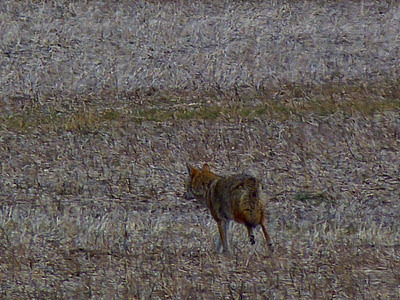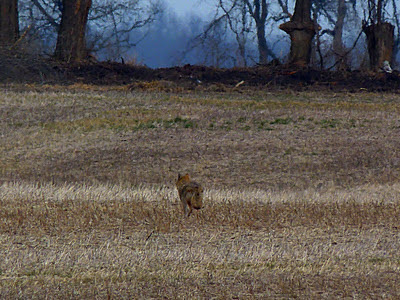Gordon Grice's Blog, page 52
June 23, 2012
Bow Fisherman Lands 8-Foot Alligator Gar

Gar-gantuan feat at Lake Corpus Christi » Corpus Christi Caller-Times:
"Even together the two men could not lift the fish. Jim offered a forklift from his garage, which was just the tool they needed to hang the catch for photos and to weigh it.
But their scale's 300-pound capacity was inadequate. The fish measured 8 feet 2 inches. And it bottomed out the scale in resounding fashion.
The actual weight, which was more than a few stones greater than 300 pounds, will never be known."
Published on June 23, 2012 01:00
June 22, 2012
Animal Attack Movies: Monster on the Campus
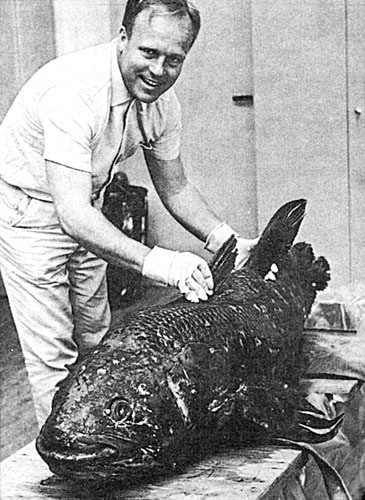
In 1938, a coelacanth was brought up from the depths near South Africa. That was a startling development because scientists were aware of the coelacanth only from the fossil record and assumed it had been extinct since the days of the T. rex. It’s an interesting fish because, as the characters in the movie mention, it’s more closely related to four-footed land animals than other fish are.
In Monster on the Campus, a scientist gets a frozen coelacanth for study. A dog laps up its melting juices; a dragonfly nibbles at the carcass; the scientist himself cuts his hand on its teeth. All these critters end up reverting to primitive forms: the dog becomes a wolf with massive fangs, the dragonfly grows to massive proportions and zooms around the lab, and the man develops a very poor attitude. The science is, as you may have gathered, a bit shaky. The drama, however, is rather good, and it surprised me in several ways. One was its humor. The scientist works at “Dunsfield University.” Get it? “Dunce Field”? When he phones up another scientists to ask for some info, the other guy turns out to be named “Dr. Moreau.” There’s some depth to the movie, too, as the characters make various references to our race’s primitive and civilized characteristics. It’s clear the filmmakers had nuclear anxiety in mind.
As a side note, I feel certain Stan Lee (or Jack Kirby?) must have loved this movie. The main character is named Dr. Donald Blake. About four years later, Lee recycled that name for Thor’s mortal alter ego in Marvel Comics. He also borrowed the movie’s gimmick of using gamma rays to turn a man into a primitive monster for the Hulk comic.
Here's the movie:
Published on June 22, 2012 03:00
Animal Attack Movies: Monster in the Campus

In 1938, a coelacanth was brought up from the depths near South Africa. That was a startling development because scientists were aware of the coelacanth only from the fossil record and assumed it had been extinct since the days of the T. rex. It’s an interesting fish because, as the characters in the movie mention, it’s more closely related to four-footed land animals than other fish are.
In Monster on the Campus, a scientist gets a frozen coelacanth for study. A dog laps up its melting juices; a dragonfly nibbles at the carcass; the scientist himself cuts his hand on its teeth. All these critters end up reverting to primitive forms: the dog becomes a wolf with massive fangs, the dragonfly grows to massive proportions and zooms around the lab, and the man develops a very poor attitude. The science is, as you may have gathered, a bit shaky. The drama, however, is rather good, and it surprised me in several ways. One was its humor. The scientist works at “Dunsfield University.” Get it? “Dunce Field”? When he phones up another scientists to ask for some info, the other guy turns out to be named “Dr. Moreau.” There’s some depth to the movie, too, as the characters make various references to our race’s primitive and civilized characteristics. It’s clear the filmmakers had nuclear anxiety in mind.
As a side note, I feel certain Stan Lee (or Jack Kirby?) must have loved this movie. The main character is named Dr. Donald Blake. About four years later, Lee recycled that name for Thor’s mortal alter ego in Marvel Comics. He also borrowed the movie’s gimmick of using gamma rays to turn a man into a primitive monster for the Hulk comic.
Here's the movie:
Published on June 22, 2012 03:00
June 21, 2012
Sharks Eat Dead Whale
At a beach in Northwest Australia, sharks devour the carcass of a whale. The post on GrindTV identifies these hungry feeders as tiger and reef sharks.
Thanks to Dee Puett
Published on June 21, 2012 01:00
June 20, 2012
The Five-Fingered Hand

I
I gazed at the silverbacked gorilla through a transparent wall. His careful fingers caressed his toes. He picked up a stem of grass from the floor, brought it to his face; his prehensile lips reached for it, wrapped it, and released it. His hand flopped to the floor; it rested there for a second, then slowly relaxed and let the stem fall.
Three young people, two women and a man, entered the humid air of the ape house, and I moved to share the view. I looked past the silverback to the leaner gorillas gathered outside in their pit, some of them lolling on rocks, some of them walking slowly on the grass, seeming careful to walk on the outer edges of their feet and the knuckles of their fingers.
Human screams startled me. The women were pointing at the silverback and covering their mouths in disgust. The man laughed nervously, then robustly. The silverback had vomited and was casually wiping up the vomitus from the concrete floor with his long right hand and licking it.
I watched the three people watching the gorilla. They discussed his behavior. One woman thought he was sick (he wasn't; gorillas just do that). The man thought the spectacle was amusing, and he teased one of the women with comparisons to her own dietary preferences. They all seemed to agree that a tremendous breach of etiquette had occurred, though none said so in quite those words. The man expressed his admiration for the gorilla's damn-the-critics attitude. They left, still loudly analyzing the event.
I stayed a moment longer trying to watch the animal's behavior with scientific detachment. But he was too damn human. I had to look away.
II.
Ever since Darwin, a doppelganger with the face of an ape has haunted art and literature.
An early example is Robert Louis Stevenson's The Strange Case of Dr. Jekyll and Mr. Hyde. Few books have been interpreted in such a monolithically similar way by the culture at large. The meaning of Jekyll and Hyde is good and evil; ask anybody. But the novelette itself doesn't read that way.
Jekyll explains Hyde as purely evil, but he depicts himself as an ordinary human being, compounded of both good and evil, powerless to resist the lure of the purer Hyde. In other words, the two characters are not a dualistic balance; the scale is weighted in favor of evil. Stevenson depicts Hyde as distinctly simian—a choice of imagery that cannot have been lost on a Victorian world bruised by Evolution.
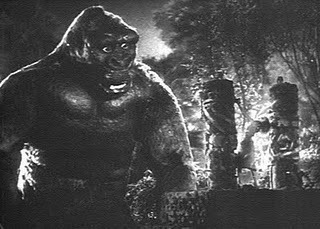
After a rash of similarly sinister appearances, the ape began to evolve into a more sympathetic figure. King Kong, the most successful popcultural representation of the ape to date, impresses many viewers as a simple-yet-noble schmoe tragically whipped by technology. Of course, he can also be seen as a big black guy who digs white chicks—a view which probably accounts for some of the film's impact on the America of the 1930s. By the 1960s, Planet of the Apes had turned our first cousins into an ironic lens for looking in a more intellectual way at ourselves. That peculiar sensation crystallizes in a scene near the end of the film: a chimpanzee tells our human hero he's almost too ugly to kiss.
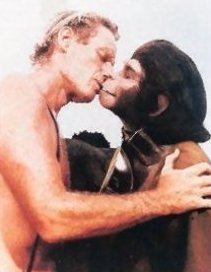
It wasn't until the 1960s that we started to study real apes in earnest. There were immediate revelations. The first was that we're not the only animals that use tools—chimps, for example, routinely use twigs to pick up ants. In 1972, a scientist named Patterson taught a gorilla named Koko sign language. The capacity for language was another trait we'd credited only to ourselves. If evolution had ruined our sense of divine preferment, the study of the great apes chipped away every other excuse for feeling superior.
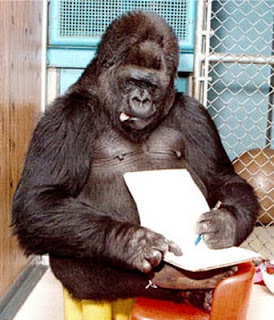
Somehow, somewhere along the way, a startling role-reversal had taken place. We started to think of apes as peace-loving near-vegetarians, never inflicting violence on anything more complex than an occasional grub. Strange as it may seem, the myth of the saintly ape was just another incarnation of human arrogance. If we couldn't be better than everybody else, we could at least take comfort in being uniquely evil. Other animals kill for food; we're the only ones who kill for fun. So the reasoning went.
But then Jane Goodall brought back footage of chimps devouring young baboons. A few years later, Goodall witnessed a chimp war. The winning band hunted down the survivors of the losing band and exterminated them.
The apes seemed more human than ever.
III.
The hand of a primate is the most disturbing thing about it. There, in a monkey's paw or an ape's, is the opposable thumb on which we formerly pinned so much of our claims. There is the instrument of so much expression. There is our kinship and our uneasy sense of difference.
Once there was an gorilla named Digit, famous in some circles for his acquaintance with Dian Fossey, the naturalist who was first touched, in something like friendship, by a wild gorilla. Poachers killed Digit for his head and his hands. If you like, you can find video of Digit's carcass being carried to Fosse's hut. His deficiencies are disorienting: at first you hardly know what you're seeing. It seems merely a black and red abstraction for violence. Poachers could sell gorilla heads, stuffed with sawdust and posed with the fangs exposed, for a trophy. Gorilla hands were used to make ashtrays and other such bric-a-brac.
If that surprises you, sit with the image a moment: Smoke coming from the bowl of long black hands, which we can't help but see as monstrously disproportionate; skin that might be wrinkled black suede, coarsened and bagged at the knuckles; and on close inspection the fingertips whorled with a forgotten identity.
This story originally appeared in Art Byte.
Published on June 20, 2012 00:30
June 19, 2012
Big Great White Sharks
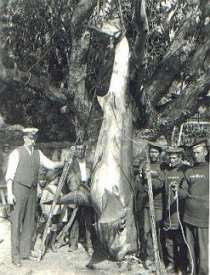
Some huge great white sharks. The stories behind these photos can be found here.

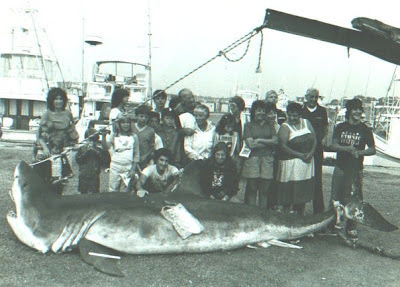
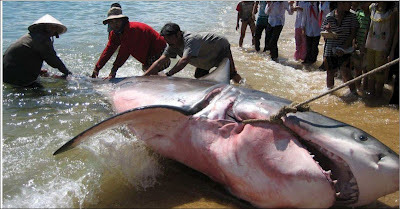
This last one shows a biologist petting a great white shark as it leaps from the water.
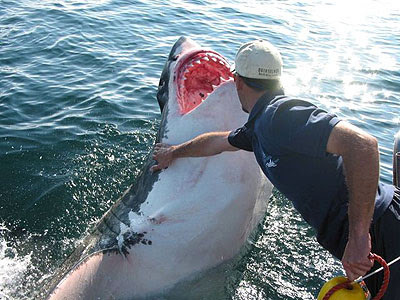
Thanks to Dee Puett.
Published on June 19, 2012 01:42
June 18, 2012
Wolves Kill Zoo Worker

My contacts who have worked with wolves tell me the animals look for any sign of weakness or even inattention. Captive wolves have attacked people who bent over or limped. The problem for a keeper is that we humans tend to get comfortable around animals that have never harmed us. We lower our guard. But a wolf is always interested in opportunities.
Reports: Swedish zoo worker killed in wolf attack - Wire World News - The Sacramento Bee:
"The experienced 30-year-old woman was by herself in the pen when the attack occurred Sunday morning. . . zoo workers often enter the area alone.
The enclosure reportedly contains eight wolves. Park workers first realized that something had gone wrong when their colleague failed to maintain radio contact.
The Aftonbladet daily quoted Hoggren as saying zoo workers and paramedics entered the pen after forming a human chain and arming one person, but it was too late."
Photo by Wayne T. Allison
Published on June 18, 2012 01:03
June 17, 2012
Coyote Retreating Across a Field
Published on June 17, 2012 03:00
June 16, 2012
Horse Retaliates Against Abuser
The narration is sensationalistic and not very infiormative, but the video is interesting.

Published on June 16, 2012 03:00
June 15, 2012
Giant Otter Injures Zoo Workers
 Eric Gaba/Creative CommonsThe giant otter is mainly a fish-eating species; humans aren't the right size to serve as its prey. Possibly the woman's scream provoked its attack.
Eric Gaba/Creative CommonsThe giant otter is mainly a fish-eating species; humans aren't the right size to serve as its prey. Possibly the woman's scream provoked its attack. German woman hospitalised after otter attack | thetelegraph.com.au:
"The 183-centimetre-long otter then attacked the woman, biting her several times on the arms and legs. A zookeeper nearby rushed to her aid, however he and an assistant were also attacked.
"We are very upset and cannot explain how this could happen," a spokesperson for the zoo said Friday.
The woman suffered serious injuries. She was reportedly put in an induced coma, and may have permanently lost the use of her arm as a result of the attack."
Published on June 15, 2012 03:00


